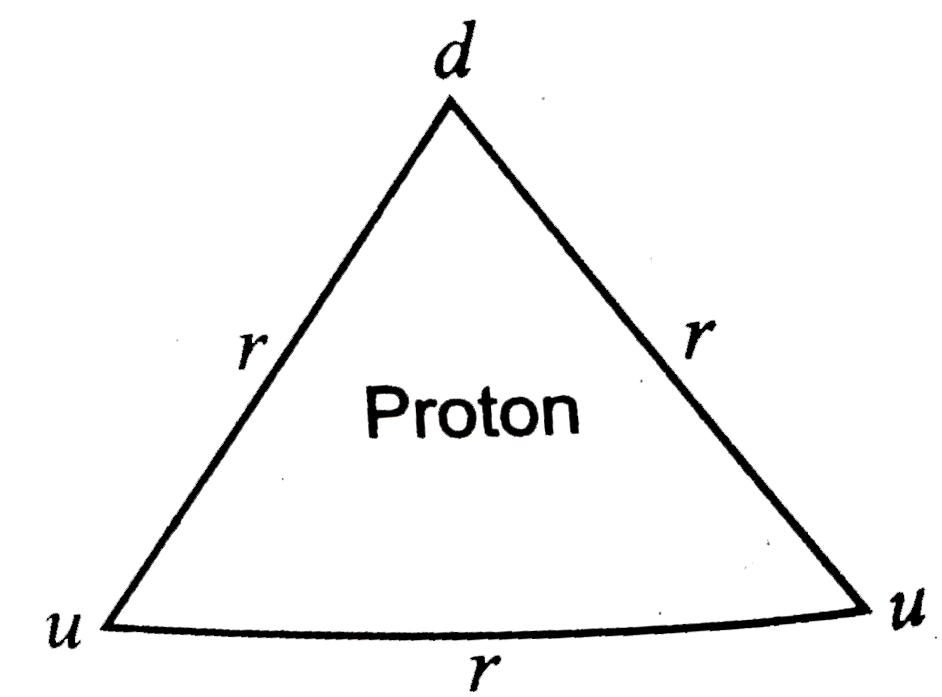(a) In a quark model of elementary particles, a neutron is made of one up quarks [charge (2/3)e] and two down quarks [charges - (1/3)e].As∑etˆtheyhavea△configurationwiths≤n>hoftheorderof10^(-15) m. Calculate electrostatic potential energy of neutron and compare it with its mass 939 MeV.
(b) Repeat above exercise for a proton which is made of two up and one down quark.
![(a) In a quark model of elementary particles, a neutron is made of one up quarks [charge (2//3)e] and two down quarks [charges - (1//3) e]. Assume that they have a triangle configuration with side length of the order of 10^(-15) m. Calculate electrostatic potential energy of neutron and compare it with its mass 939 MeV. (b) Repeat above exercise for a proton which is made of two up and one down quark.](https://d10lpgp6xz60nq.cloudfront.net/physics_images/PR_XII_V01_C01_S01_639_Q01.png)
Fig shows quark model of a neutral, where r=10−15m.
Potential energy of neutron
U=14π∈0r[qeqd+quqd+quqd]
=9×10910−15[(−e3)(−e3)+(2e3)(−e3)+(2e3)(−e3)]
U=9×10910−15(19−49)(1.6×10−19)2=−7.68×10−14J
U=−7.68×10−141.6×10−19eV=−4.8×105eV=−0.48MeV
mnC2=939MeV∴UmnC2=0.48939=5.11×10−4
Proceed similarly for a proton whose quark model in shown in Fig.

Similar Questions
In a quark model of elementary particles, a neutron is made of one up quark (charge =23e) and two down quarks (charges =13e). Assume that they have a triangle configuration with side length of the order of 10−15m. Calculate electrostatic potential energy of neutron.
View SolutionCalculate the electrostatic potential energy for a system of three point charges q placed at the corners of an equilateral triangle of side ‘a’.
View Solution
Knowledge Check
- Question 1 - Select One
The neutron is a particle with zero charge still it has a non-zero magnetic moment with z-component 9.66×10−27A−m2. This can be explained by the internal structure of the neutron. The evidence indicates that a neutron is composed of three fundamental particles calleed quarks : an up (u) quark, of charge +2e3, and two down (d) quarks, each of change −e3. The combinations of the three quarks prodcues a net charge of 2e3−e3−e3=0.
_E01_154_Q01.png)
If the quarks are in motion they can produce a non-zero magnetic moment. As a very simple model, suppose the u quark moves in a counter clockwise circular path and the d quarks move in a clockwise circular path, all of the radius r and all with the same speed v see figure.
If all Quarks start moving in the same direction then what will be the magnetic moment of the neutron :-Aevr3πrB2evr3CevrDNone of these
Three charges +q,2qand−4q are placed on the three vertices of an equale-laterail triangle of each side0⋅1m. Calculate electrostatic potential energy of the system, take q=10−7C
View SolutionCompare a proton and a neutron in respect of mass and charge.
View SolutionCompare an electron, a proton and a neutron in respect of their relative masses and charges.
View SolutionCalculation OF charge in space by E ||Electrostatic Potential
View SolutionThree charges of 1 nC, 2 nC and 3 nC are placed at the corners of an equilateral triangle of side √3m. Calculate electrostatic potential at a point equidistant from the three corners of the triangle.
View SolutionDefine a neutron. Mention its mass and charge.
View SolutionGive the mass and charge of an electron , a proton and an neutron in kg and coulombs repectively .
View Solution

